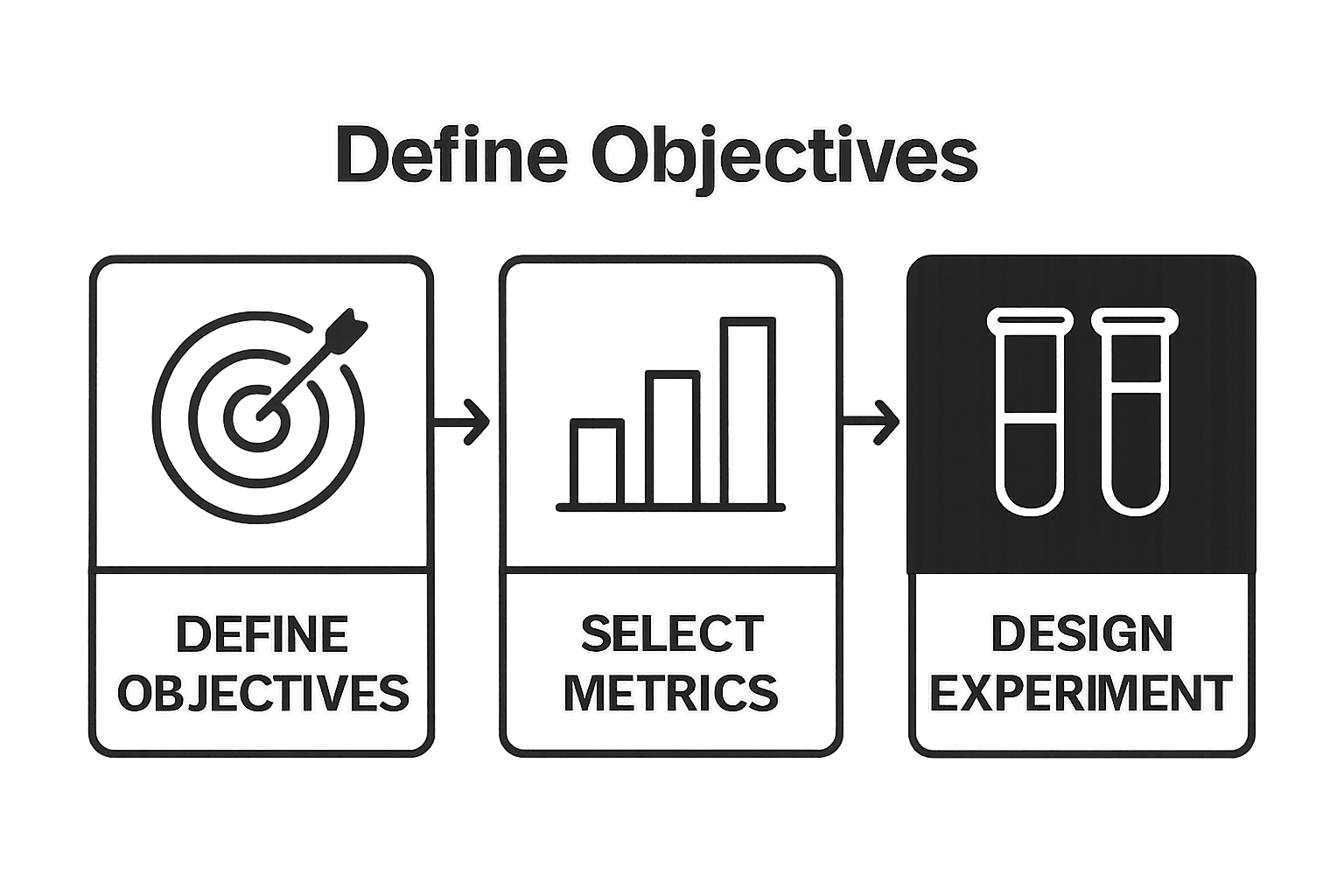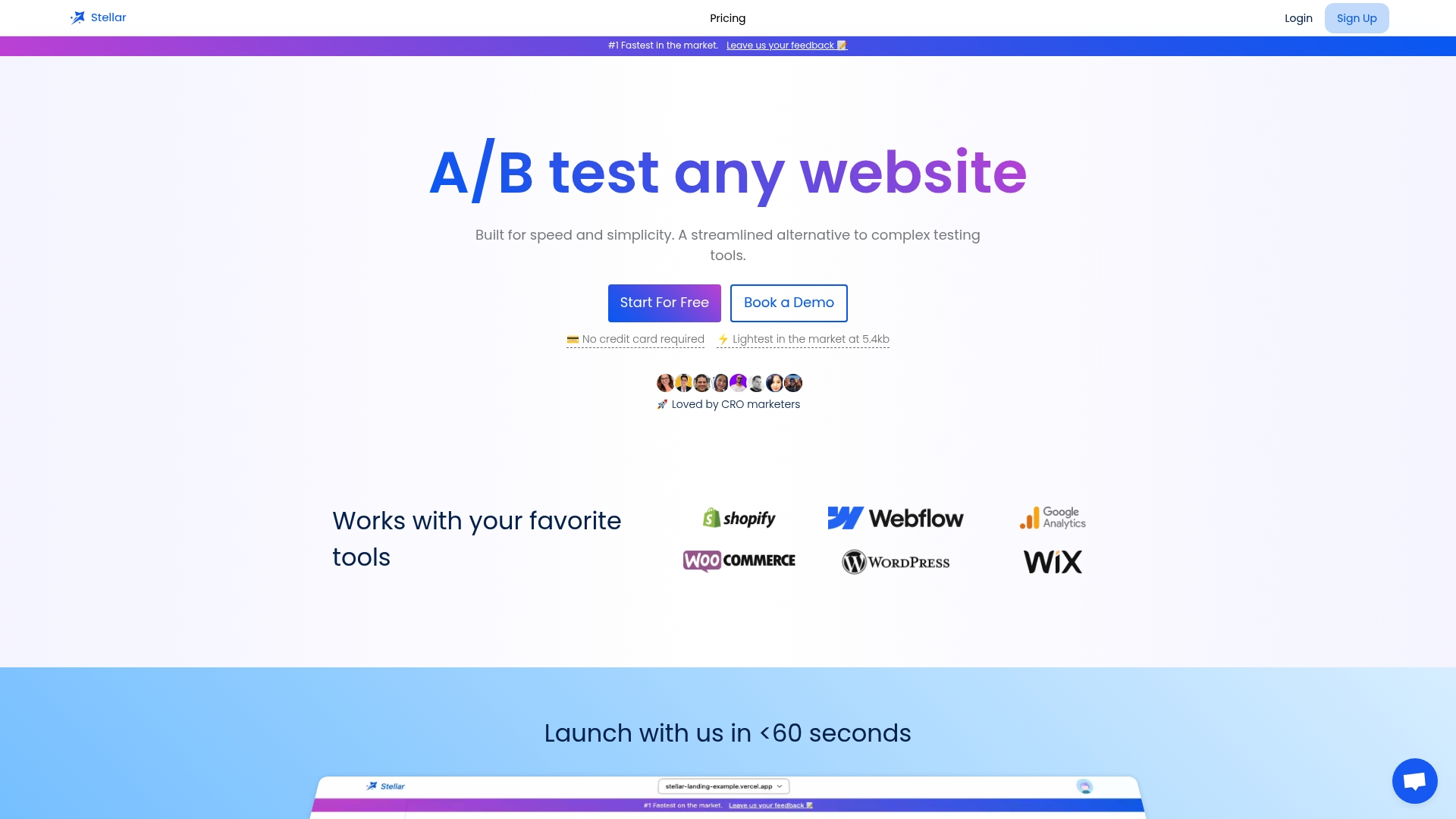
Simplifying Experimentation Process for Optimal Results

Setting up a solid experiment can transform wishful thinking into measurable business results and it starts long before any data gets collected. Most people think experiments hinge on fancy tools or endless data points but the heart of successful optimization is much simpler. What really drives breakthrough outcomes is how you define your experiment objectives from the start and experiments with clear, quantifiable goals lead to much higher odds of success according to research published in Nature. Curious how a single shift in approach can mean the difference between insight and wasted effort? This will flip how you approach experimentation entirely.
Table of Contents
- Step 1: Define Your Experiment Objectives
- Step 2: Identify Key Metrics For Success
- Step 3: Select The Right Experimentation Tools
- Step 4: Design Your Experiment Framework
- Step 5: Execute The Experiment With Precision
- Step 6: Analyze Results And Implement Improvements
Quick Summary
| Key Point | Explanation |
|---|---|
| 1. Define clear experiment objectives | Establish specific, quantifiable goals to guide your research and optimization efforts effectively. |
| 2. Identify business-critical metrics | Focus on metrics directly related to revenue and user experience to assess experimental impact accurately. |
| 3. Choose the right experimentation tools | Select tools that integrate easily with your systems and offer robust features without requiring extensive coding skills. |
| 4. Craft a precise hypothesis | Develop testable hypotheses linking variables directly related to your objectives for effective analysis. |
| 5. Analyze results deeply for insights | Examine data comprehensively to derive meaningful insights and inform strategic improvements in user experience. |
Step 1: Define Your Experiment Objectives
Successful experimentation begins with crystal clear objectives that transform abstract ideas into actionable research strategies. Crafting precise experiment objectives is more than a preliminary step - it's the foundational blueprint that guides your entire optimization journey.
When defining your experiment objectives, start by asking strategic questions that reveal the core insights you want to uncover. What specific metric are you attempting to improve? Are you seeking to increase conversion rates, reduce cart abandonment, or enhance user engagement? Your objectives must be quantifiable and measurable, moving beyond vague aspirations to concrete, trackable goals.

Read more about prioritizing your experiments by understanding which objectives will deliver maximum impact. The most effective experiment objectives share several critical characteristics: they are specific, time-bound, realistic, and aligned with broader business goals. For instance, instead of a generic goal like "improve website performance," a precise objective might read: "Increase landing page conversion rate by 15% within the next 30 days by optimizing call-to-action button placement and color scheme."
To develop robust experiment objectives, consider creating a structured framework that captures key performance indicators. According to research from Nature, well-defined research objectives significantly enhance experimental design and outcomes. Your framework should include:
- A clear statement of the metric you want to change
- The expected magnitude of change
- The specific element or variable you will modify
- The timeframe for achieving the objective
Remember that your experiment objectives are not static documents but living guides that may evolve as you gather initial insights. Remain flexible and willing to refine your objectives based on preliminary data, ensuring your experimental approach remains adaptive and responsive to emerging findings.
Step 2: Identify Key Metrics for Success
Identifying key metrics transforms experimental data from abstract numbers into meaningful insights that drive strategic decision making. These metrics serve as the critical compass that guides your entire experimentation process, helping you understand whether your efforts are genuinely moving the needle for your business objectives.
Before diving into metric selection, understand that not all metrics carry equal weight. Business-critical metrics demand your primary attention - these are the quantitative indicators directly tied to revenue, user experience, and long term growth. Conversion rates, average order value, customer lifetime value, and user engagement represent prime examples of metrics that provide substantive performance insights.
Learn more about analytics dashboards to help visualize and interpret your experimental results effectively. When selecting metrics, prioritize those that are both actionable and directly influenced by your experimental changes. For example, if you are testing a new checkout page design, relevant metrics might include conversion rate, average transaction value, and cart abandonment rate.
To ensure comprehensive metric tracking, consider establishing a hierarchical approach that distinguishes between primary and secondary metrics. Primary metrics are your main performance indicators - the direct measurements that validate whether your experiment successfully achieved its core objective. Secondary metrics provide contextual insights, revealing potential unintended consequences or subtle shifts in user behavior that might not be immediately apparent.
Critical metrics to consider across different experimental contexts include:
- Conversion rate
- Revenue per visitor
- Customer acquisition cost
- User engagement duration
- Bounce rate
Remember that metric selection is not a one-size-fits-all process. Each experiment requires thoughtful consideration of which measurements will most accurately reflect meaningful progress toward your specific goals. By carefully curating your metrics, you transform raw data into a powerful narrative of user behavior and business performance.
This table organizes critical metrics mentioned in the guide, showing their focus area and when to prioritize each metric during digital experimentation.
| Metric | Focus Area | When to Prioritize |
|---|---|---|
| Conversion Rate | Website/User Actions | Testing changes to user flows or CTAs |
| Average Order Value | Revenue/Profitability | Trials impacting pricing or cross-sells |
| Customer Lifetime Value | Retention/Business Impact | Initiatives to boost long-term loyalty |
| User Engagement Duration | Experience/Interaction | Experiments aiming to increase site usage |
| Bounce Rate | Initial User Impressions | First-page UX or landing page optimizations |
| Revenue per Visitor | Business Performance | Direct ROI and sales-focused tests |
| Customer Acquisition Cost | Marketing Efficiency | New user funnel or campaign experiments |
Step 3: Select the Right Experimentation Tools
Selecting the right experimentation tools is a critical decision that can make or break your optimization efforts. The ideal tool transforms complex testing processes into streamlined, insightful experiences that empower data driven decision making. Your chosen platform should not just collect data, but provide intuitive interfaces and powerful analytics that turn raw information into actionable strategies.
When evaluating experimentation tools, focus on platforms that offer seamless integration with your existing tech stack and provide robust features tailored to your specific business needs. Look for solutions that minimize technical complexity while maximizing experimental depth. The best tools enable you to design, implement, and analyze tests without requiring extensive coding knowledge or dedicating entire engineering teams to the process.
Explore strategies for scaling A/B testing efforts that can help you maximize your tool selection. Consider tools that provide comprehensive capabilities such as visual editors, advanced targeting options, and real time reporting. These features allow you to create nuanced experiments that go beyond simple binary comparisons, enabling more sophisticated user experience optimizations.
According to research from ResearchGate, tool selection profoundly impacts experimental data integrity and scalability. Prioritize platforms that offer:
- Intuitive visual experiment builders
- Comprehensive statistical significance calculations
- Granular audience segmentation capabilities
- Robust data visualization tools
- Cross device and cross platform compatibility
Beyond technical specifications, evaluate each tool's ability to align with your specific business context. Consider factors like your typical website traffic, complexity of experiments you want to run, and the level of statistical sophistication required. The right tool should feel like an extension of your team - simplifying complex processes while providing deep, meaningful insights that drive continuous improvement.
Step 4: Design Your Experiment Framework
Designing a robust experiment framework is the architectural blueprint that transforms theoretical concepts into actionable research strategies. This critical step determines the structural integrity of your entire experimental process, ensuring that your research yields meaningful, reliable insights that drive strategic decision making.
Begin by crafting a precise and testable hypothesis that clearly articulates the expected relationship between your variables. Your hypothesis should be specific, measurable, and directly linked to the objectives established in earlier steps. Think of it as a focused prediction that outlines exactly what change you anticipate and why.
For instance, instead of a vague statement like "we think users might prefer this design," construct a hypothesis that reads: "Changing the call to action button color from blue to green will increase conversion rates by at least 10% among mobile users."
Discover optimal test duration recommendations to ensure your experimental framework captures statistically significant data. When structuring your experiment, pay close attention to creating controlled and randomized conditions that minimize external variables. This means segmenting your audience randomly and ensuring that test and control groups are as similar as possible, with the only meaningful difference being the specific variable you are testing.
According to research from NIH, a well-designed experimental framework incorporates key principles that reduce bias and enhance result validity. Your framework should include:
- Clear definition of independent and dependent variables
- Predetermined sample size calculations
- Specific inclusion and exclusion criteria
- Detailed data collection protocols
- Predefined statistical analysis methods
Critically, your experimental design must account for potential confounding factors that could skew results. This requires a methodical approach to isolating the specific variable under investigation while maintaining experimental rigor. By meticulously planning each aspect of your experimental framework, you transform raw data collection into a precise, insightful research methodology that delivers actionable business intelligence.
Step 5: Execute the Experiment with Precision
Executing an experiment with precision transforms your carefully crafted research strategy from theoretical planning into tangible, actionable insights. This critical phase demands meticulous attention to detail, unwavering commitment to your established protocol, and a disciplined approach to data collection and management.
Begin by double-checking all technical configurations to ensure your experiment runs smoothly across different user segments and devices. Verify that tracking mechanisms are correctly implemented, audience segmentation is precise, and all experimental variants are functioning exactly as designed. Even minor technical glitches can introduce significant bias or compromise your entire experimental results.
Explore our comprehensive A/B testing checklist to ensure you don't overlook critical execution details. During the experiment, maintain strict neutrality and avoid making any assumptions or premature interventions. Your role is to observe and record, not to influence the outcome. This means resisting the temptation to modify experimental parameters midway or introduce external variables that could skew your results.
According to research from MDPI Sensors, consistent protocol execution is paramount for experimental reliability. Your experimental execution should focus on:
- Maintaining exact replication of experimental conditions
- Preventing cross-contamination between test groups
- Ensuring consistent data tracking mechanisms
- Monitoring for unexpected system interactions
- Recording all observations with extreme precision
Real time monitoring becomes crucial during this phase. While you want to avoid interfering with the experiment, you also need to stay alert for any significant anomalies that might require immediate attention. This involves setting up robust tracking systems that provide comprehensive visibility into your experiment's performance without introducing additional bias. By executing your experiment with surgical precision, you transform raw data into a strategic asset that can drive meaningful business improvements.
Step 6: Analyze Results and Implement Improvements
Analyzing experimental results transforms raw data into strategic insights that drive meaningful business transformation. This critical phase is where your meticulous planning and precise execution culminate in actionable intelligence that can fundamentally reshape your approach to user experience and performance optimization.
Begin by examining statistical significance with a rigorous and objective lens. Do not rush to conclusions based on surface level observations. Instead, dive deep into the data, understanding not just what happened, but why it happened. Look beyond simple percentage changes to uncover the underlying behavioral patterns and psychological triggers that influenced user interactions during your experiment.
Explore proven methods for analyzing split test results to enhance your interpretation skills. When reviewing your experimental outcomes, consider both the quantitative metrics and the qualitative insights. Numbers tell a story, but context provides the narrative. Pay attention to anomalies, unexpected patterns, and potential interaction effects that might reveal more nuanced understanding of user behavior than straightforward statistical comparisons.
According to research from PubMed, continuous improvement relies on comprehensive result assessment. Your analysis should focus on:
- Determining statistical significance of observed changes
- Identifying potential confounding variables
- Understanding directional impact on key performance indicators
- Evaluating long term implications of experimental findings
- Developing clear recommendations for implementation
Implementation is not about wholesale adoption but strategic integration. Translate your findings into precise, incremental changes that can be further tested and refined. Approach each result as a stepping stone toward deeper understanding, recognizing that true optimization is an iterative process of continuous learning and adaptation. By treating your experimental results as a dynamic roadmap rather than a fixed destination, you create a powerful framework for ongoing business evolution.

Transform Your Experimentation Into Real Business Impact
Are you tired of the confusion and wasted time that comes with complicated A/B testing processes? In the article "Simplifying Experimentation Process for Optimal Results" you learned the importance of clear objectives, actionable metrics, and precise execution. But even with the right strategy, traditional tools often slow you down, frustrate your team, and hurt your website performance. You deserve results without the guesswork and complexity.

Stop letting technical obstacles hold back your growth. With Stellar, you get the fastest SaaS A/B testing platform built for marketers and growth hackers. Our no-code visual editor and lightweight 5.4KB script make setup simple while powerful analytics help you move from test design to actionable insights in record time. Marketers who want to align clear goals and effective decision-making can start experimenting today and see a measurable difference in both speed and website experience. Take the next step and discover how Stellar streamlines every step of your experimentation process. Get started now while your competitors are still struggling with slow, complex tools.
Frequently Asked Questions
What are the key steps in simplifying the experimentation process?
Successful experimentation involves defining clear objectives, identifying key metrics, selecting appropriate tools, designing a robust framework, executing with precision, and analyzing results to implement improvements.
To help you quickly reference each stage of the experimentation process, here is a summary table outlining each main step, its primary focus, and the key outcome to expect.
| Step | Primary Focus | Key Outcome |
|---|---|---|
| Define Objectives | Set clear, quantifiable goals | Actionable research direction |
| Identify Key Metrics | Select relevant success metrics | Focused, impactful measurement |
| Select Tools | Choose integrated, user-friendly tools | Streamlined experiment setup |
| Design Framework | Establish controlled, testable structure | Reliable experimental environment |
| Execute with Precision | Perform experiment as planned | Accurate, unbiased data collection |
| Analyze & Improve | Interpret results and apply changes | Continuous business optimization |
How do I define effective experiment objectives?
Effective experiment objectives should be specific, time-bound, realistic, and aligned with broader business goals. They should also be quantifiable and measurable, focusing on metrics like conversion rates or user engagement.
What metrics should I focus on during experimentation?
Focus on business-critical metrics that directly influence revenue and user experience, such as conversion rates, average order value, and customer lifetime value. These metrics should be actionable and influenced by your experimental changes.
How can I ensure my experiments yield reliable results?
To yield reliable results, ensure you follow a structured design, maintain controlled conditions, accurately segment your audience, and adhere to consistent protocols during data collection and analysis.
Recommended
Published: 10/2/2025